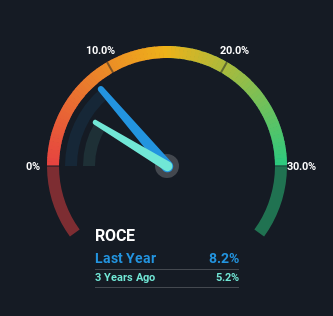What are the early trends we should look for to identify a stock that could multiply in value over the long term? Amongst other things, we'll want to see two things; firstly, a growing return on capital employed (ROCE) and secondly, an expansion in the company's amount of capital employed. This shows us that it's a compounding machine, able to continually reinvest its earnings back into the business and generate higher returns. Although, when we looked at RATH (VIE:RAT), it didn't seem to tick all of these boxes.
What Is Return On Capital Employed (ROCE)?
For those that aren't sure what ROCE is, it measures the amount of pre-tax profits a company can generate from the capital employed in its business. To calculate this metric for RATH, this is the formula:
Return on Capital Employed = Earnings Before Interest and Tax (EBIT) ÷ (Total Assets - Current Liabilities)
0.082 = €8.9m ÷ (€132m - €24m) (Based on the trailing twelve months to June 2023).
Therefore, RATH has an ROCE of 8.2%. Ultimately, that's a low return and it under-performs the Basic Materials industry average of 10%.
See our latest analysis for RATH

While the past is not representative of the future, it can be helpful to know how a company has performed historically, which is why we have this chart above. If you're interested in investigating RATH's past further, check out this free graph of past earnings, revenue and cash flow.
So How Is RATH's ROCE Trending?
There are better returns on capital out there than what we're seeing at RATH. The company has employed 22% more capital in the last five years, and the returns on that capital have remained stable at 8.2%. Given the company has increased the amount of capital employed, it appears the investments that have been made simply don't provide a high return on capital.
What We Can Learn From RATH's ROCE
Long story short, while RATH has been reinvesting its capital, the returns that it's generating haven't increased. Since the stock has gained an impressive 52% over the last five years, investors must think there's better things to come. However, unless these underlying trends turn more positive, we wouldn't get our hopes up too high.
If you'd like to know more about RATH, we've spotted 5 warning signs, and 2 of them make us uncomfortable.
If you want to search for solid companies with great earnings, check out this free list of companies with good balance sheets and impressive returns on equity.
New: AI Stock Screener & Alerts
Our new AI Stock Screener scans the market every day to uncover opportunities.
• Dividend Powerhouses (3%+ Yield)
• Undervalued Small Caps with Insider Buying
• High growth Tech and AI Companies
Or build your own from over 50 metrics.
Have feedback on this article? Concerned about the content? Get in touch with us directly. Alternatively, email editorial-team (at) simplywallst.com.
This article by Simply Wall St is general in nature. We provide commentary based on historical data and analyst forecasts only using an unbiased methodology and our articles are not intended to be financial advice. It does not constitute a recommendation to buy or sell any stock, and does not take account of your objectives, or your financial situation. We aim to bring you long-term focused analysis driven by fundamental data. Note that our analysis may not factor in the latest price-sensitive company announcements or qualitative material. Simply Wall St has no position in any stocks mentioned.
About WBAG:RAT
RATH
Engages in the production and sale of refractory materials in Europe, Africa, the Middle East, the Americas, and the Asia Pacific.
Slight risk and slightly overvalued.
Market Insights
Community Narratives




